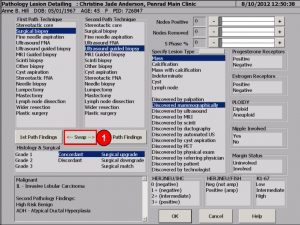PenRad’s biopsy exams accommodate multiple biopsies – either unilateral or bilateral, and facilitate a “super bill” concept with a common accession number (all-in-one report) for documentation of biopsy guidance imaging, post biopsy imaging clip placement, and specimen imaging by abnormality. This allows facilities to consolidate order types for stereos, US bx, MRI bx, NM bx and FNA exams to a number of sites concept, instead of individual separate orders for each biopsy and individual components – biopsy guidance imaging order, post imaging placement order, and specimen imaging order.
PenRad automatically creates a pathology exam from the biopsy procedure (inherits the biopsy abnormality information) that facilitates the statistics for the screening and diagnostic exam association. The automatic system creates and facilitates a common pathology exam record when multiple biopsies are performed within the same biopsy exam.
For facilities not accommodating multiple biopsies within a common biopsy exam, the option is now available that applies all biopsy findings to a common pathology exam for the day eliminating the individual pathology exam by abnormality, streamlining data correlation.
Within the biopsy exam, users can suspend the exam awaiting pathology results or the option exists to distribute a preliminary report. Many RIS systems facilitate preliminary exam report distribution and distribute the final report when received from PenRad that then includes the pathological findings (pathology exam is automatically populated) when received and the next recommendation, versus an amendment.

Also added is a semi-automatic method to transfer secondary pathologic finding into most relevant pathology finding (path1) for statistics, by tapping the Swap (1) button. For example; if secondary path is a surgical procedure and it is an upgrade from original biopsy pathology (path1) or if its rebiopsy because the pathological findings were not concordant with imaging.

As a tip, the pathology selection screen has various sub-category filtering to aid in the selection of pathology types by selecting the primary classification; benign, high risk or malignant first, then the sub category, for example invasive, ductal, etc.
Recommendation for product development?
[email protected] | 763.475.3388
© 2019 PenRad Technologies, Inc. 730-23-00171 AB
